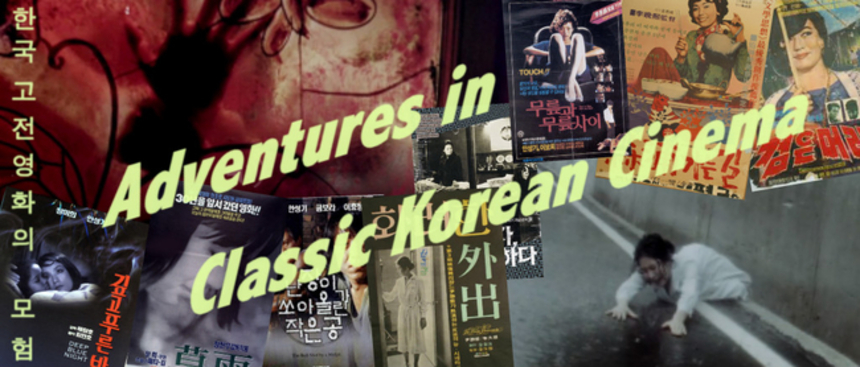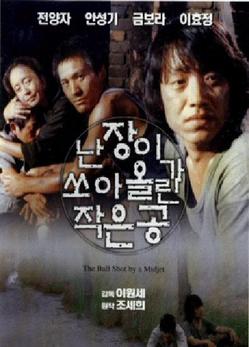Adventures in Classic Korean Cinema: THE BALL SHOT BY A MIDGET

Adventures in Classic Korean Cinema is a bi-weekly feature looking back at classic South Korean Cinema.
 Korean Cinema, especially when at its best, frequently explores pressing themes and social realities to thrilling effect. The deeper I delve into classic Korean Cinema, the clearer it becomes that this has always been the case. Throughout Korean film history, the only real difference is that the issues mined by filmmakers have changed over time. One such trait has been encroaching urbanization and among the best examples of its representation on screen is Lee Won-se's The Ball Shot by a Midget (1981).
Korean Cinema, especially when at its best, frequently explores pressing themes and social realities to thrilling effect. The deeper I delve into classic Korean Cinema, the clearer it becomes that this has always been the case. Throughout Korean film history, the only real difference is that the issues mined by filmmakers have changed over time. One such trait has been encroaching urbanization and among the best examples of its representation on screen is Lee Won-se's The Ball Shot by a Midget (1981).
This trend can be seen in Korean films spanning a few decades starting in the 1960s, once the dust began to settle after the Korean War. In fact, its emergence is not dissimilar to the rise of the nuclear family in post-war Japan, which was so eloquently depicted in films such as Ozu Yasujiro's Tokyo Story (1953). The first time I noticed this theme in a Korean feature was with what was probably one of the last works to fully embrace it. The film was Lee Chang-dong's debut Green Fish (1997), in which a young Han Suk-kyu (Shiri, 1999) returns from his military service only to find that his quiet hamlet has been swallowed up by the identical, listless residential towers of Seoul's breathless urban sprawl.
Made 16 years earlier, The Ball Shot by a Midget, based on a novel by Cho Se-hui, may well be the most direct exploration of the effects of urbanization made in Korea. Given its very political content, it's a wonder that it was made at all, though its script did have to weather two rounds of censorship and the finished product suffered a number of additional cuts.
A little person, his wife and their three grown children live a hard life in a shack beside a salt field in rural Korea. Things are already hard for the family when an eviction notice is handed to them and all their neighbors. Realizing they will be unable to afford housing when they are eventually kicked out, they face some difficult choices.
By featuring the family patriarch as a little person, the protagonist's restricted height can be seen as a metaphor for his emasculation as he his unable to save his family from its fate. The fact that he finds solace by sitting on top of a tall, thin structure that towers over the ground seems only to reinforce this notion. It's an apt metaphor but perhaps not one that is very politically correct, I can't imagine it going over so well today.
Lee's film is a wonderful realist work, which, while seemingly quiet and introspective, burns with an inner fury. As a film made at the beginning of the Chun Doo-hwan administration, it bridges the styles of some of the literary fare of the 1970s and the Korean New Wave films of Park Kwang-su (Chilsu and Mansu, 1988) and others that would follow. The dialogue, coming from the pages of Cho's novel, is filled with meaning and almost lyrical while the aesthetic, reflecting the realities of the lower classes, is earthy and grungy. As far as the cast goes, the standout, predictably, is screen legend Ahn Sung-kee (Nowhere to Hide, 1999) in an early lead role. As the elder son, he exudes gravitas and embodies the pain and confusion of an incoming generation. Remarkably, he does so with a reticent and languorous performance, transmitting much of his character's inner turmoil through his eyes.
Societies, as well as the issues and themes that they promulgate, are constantly evolving. Seoul's sprawl has slowed to a crawl, but lingering issues with urbanization have morphed into concerns over excessive consumerism, cultural bankruptcy and the intellectual and moral degradation of the country's youths. Works such as The Ball Shot by a Midget and Green Fish have presented urban space as a faceless, unfeeling and corrupting entity. While fingers can be pointed at certain high-ranking individuals, the injustice here arises at a societal level. It's harder and slower to fix. Perhaps in acknowledgment of this, Lee's film, made mere months after the horrific Gwangju Massacre, is less a call to arms than a sad snapshot of the harsh realities suffered by citizens of a country whose social development could never hope to match its economic one.
-thumb-650x273-37798.jpg)







